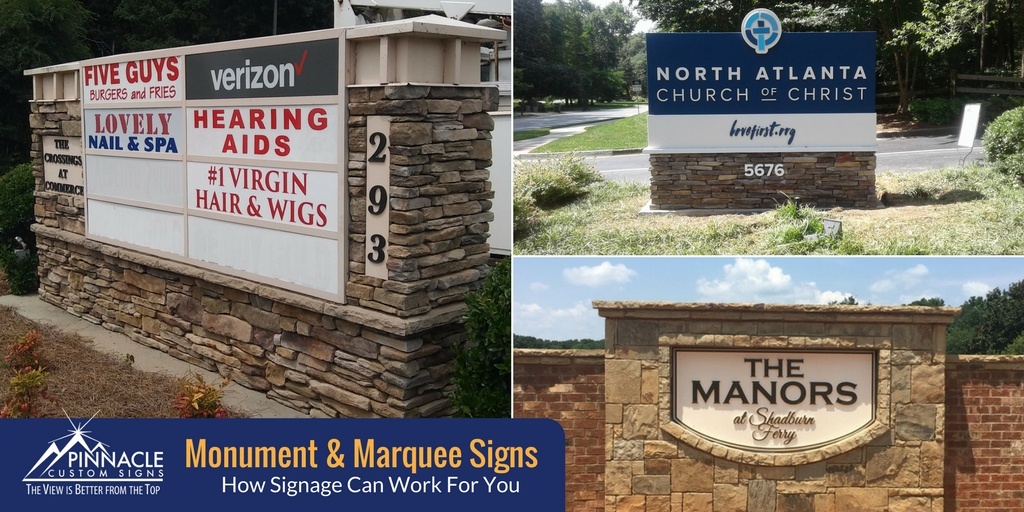When you are driving down the road and see a sign on the side of the road with a business name on it, that is a monument sign. Retail businesses, subdivisions, churches, schools, all use monument signs to catch the eye of motorists, building brand awareness. The more eye-catching the sign, the more likely someone is to remember it.
Any business owner knows, that building brand recognition and directing potential customers to their location is important for growing their business. In this article, we’re going to talk about how monument signs help to accomplish that goal and about who uses them, why they use them, what types are there, and what restrictions there are.
Why use monument signs?
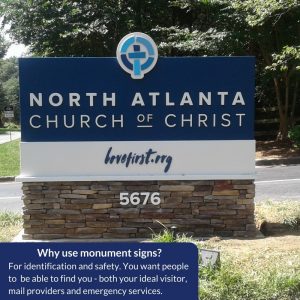 First of all, identification is key. You want to identify who you are so that potential customers can find you. Next would be branding. You see branding happening all the time. Not only are you identifying yourself, you’re putting your brand out there. We have one customer that we work with all the time that’s called Work Anytime. Their logo was a 24/7 circle, and they want to make sure that that logo, along with the name Work Anytime, appears everywhere they possibly can, so that includes branding it on monument signs.
First of all, identification is key. You want to identify who you are so that potential customers can find you. Next would be branding. You see branding happening all the time. Not only are you identifying yourself, you’re putting your brand out there. We have one customer that we work with all the time that’s called Work Anytime. Their logo was a 24/7 circle, and they want to make sure that that logo, along with the name Work Anytime, appears everywhere they possibly can, so that includes branding it on monument signs.
Safety as well. You wouldn’t think about this, but most monument signs you see out there have the address of the property on it. That’s so that first responders, fire, police, rescue, will know the address of that building, and not have to look at the building to figure out what the address is. So you see monument signs all the time incorporate that little aspect of safety as well.
How do monument signs help drive business?
Well, first of all, it drives traffic. People see that sign on the side of the road and say, “Hey. I want to go eat there. I want to go shop there. I want to go meet the people there.” So it does drive traffic to the business.
It enhances visibility. Not only do you have a sign on the building, but now you have a sign on the street, so you have the name of the business, the name of the company more than one place, from a visibility standpoint. And it’s eye catching. If you design a monument sign the right way, it can look really cool, and catch someone’s eye, so it’s not just a piece of stone sitting there, with just a name on it. If it’s designed correctly, a good monument sign will do all three of these things, drive traffic, enhance visibility, and be eye catching.
Who Uses Monument Signs?
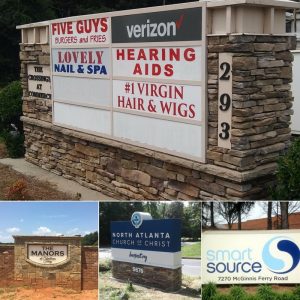 Property managers, who manage shopping centers, want to make sure that, as they negotiate leases, they have an opportunity to put that business’s name and brand on a marquee sign in that main monument sign closer to the road. That gives that business more visibility; and, with the more visibility, the business will then have a better opportunity for generating business, staying in that space, continuing on with its lease in that space.
Property managers, who manage shopping centers, want to make sure that, as they negotiate leases, they have an opportunity to put that business’s name and brand on a marquee sign in that main monument sign closer to the road. That gives that business more visibility; and, with the more visibility, the business will then have a better opportunity for generating business, staying in that space, continuing on with its lease in that space.
Stand-alone businesses use monument signs all the time. It gives them an opportunity to have more visibility for their business, to brand their business once more, to say, “Hey, this is Conklin Incorporated. We are here.” So you see that a lot with stand-alone buildings as well.
Subdivisions brand themselves with a sign that says whatever the name of the subdivision is. It helps residents and guest find their way. It also helps identify what kind of subdivision it is, based on the type of materials used and the design of the sign.
And lastly, we see a lot of churches using monument signs to show people who they are, what their name is, what their times of worship are, etc.
Types of Monument Signs
Let’s talk about what types of monument signs there are.
Tenant Signs
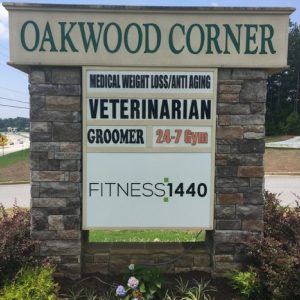 First of all, there’s a single tenant sign. If you have a building, and you’re the single tenant in that building, be it a retail space, a food space, or some other space, then you can put up a monument sign that has just your name on it, or a single tenant name on it.
First of all, there’s a single tenant sign. If you have a building, and you’re the single tenant in that building, be it a retail space, a food space, or some other space, then you can put up a monument sign that has just your name on it, or a single tenant name on it.
Then there are multiple tenant signs. You see these mainly at shopping centers. Think about a Publix or a Kroger shopping center where you have the big Kroger sign or Publix sign at the top of that sign; and then you have multiple tenants below it, for the individual people who rent the spaces in that shopping center. They want recognition and visibility for their name as well.
Residential Signs
There are also residential monument signs. Most subdivision that you see will have a monument sign out front saying the name of that subdivision – Shady Oaks, or Mulberry Station, or something like that. It’s key for marking that residential property.
Lighted vs Unlighted Signs
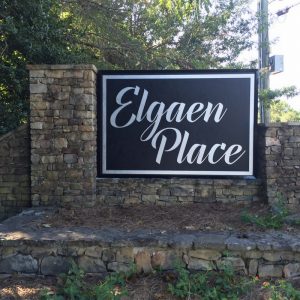 Then there are lighted versus unlighted signs. Unlighted signs versus lighted signs, it depends on the preference and the visibility. As you probably would recognize, most residential signs are not lighted. Sometimes they’ll have landscaping light indirectly lighting the sign, but most residential signs are not going to be lighted signs.
Then there are lighted versus unlighted signs. Unlighted signs versus lighted signs, it depends on the preference and the visibility. As you probably would recognize, most residential signs are not lighted. Sometimes they’ll have landscaping light indirectly lighting the sign, but most residential signs are not going to be lighted signs.
Most multiple tenant signs will be lighted signs because the property manager of that complex would like to have as much visibility for its customers, its paying tenants, as it possibly can. For a single tenant, it is totally a preference issue. If their business is only open during the day and they don’t want the expense of a lighted sign, they may go with an unlighted sign.
What types of materials can be used?
One type of material we see all the time is stone – be it brick, stack stone, or some sort of other type of stone. It adds a nice look to it, a nice feel to it, and most customers would look at it, and say, “I’d like some stone on my sign.” But stone is also an expensive option.
You can also go the foam route. We use a process that can make any type of sign look like it’s made out of a specific material, but it’s actually made out of foam and formed to look like something else. The foam can look like brick. It can look like stone. It can look like stucco. It can look like wood. We’ve made some fairly large signs out of foam, and the cost of the foam versus the cost of stone is about 25% less. So you can get a much bigger sign for the same cost as if you use stone.
The other type of foam that we use is what we call high density urethane, or HDU for short. HDU is a panel that you can route either the company’s name or the subdivision name, and you paint it. And then that HDU panel fits onto or into the monument sign that you’ve either built out of stone or foam.
When you’re looking at a lighted sign, an internally lighted sign, we use aluminum boxes to do that. Whether it’s just a plain light box or push through acrylic, aluminum is used all the time. When we do use an aluminum sign, we typically place that aluminum sign on a base made of either stone or foam.
Sign Restrictions
There are some restrictions to be careful about. Jurisdictional restrictions and regulations from your city, your county, your state can change what materials and designs you are allowed to use.
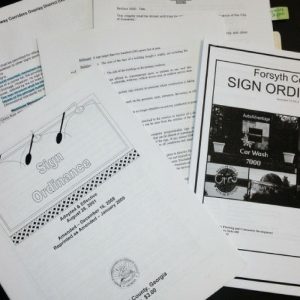
For example, in Gwinnett County, Georgia, for you to have a monument sign, you have to use a stone or brick base. No exceptions. So, no matter what you are doing from a design standpoint, you need to make sure that you meet that restriction. You also have to place the sign 15 feet back from the right of way. That’s just two examples. In Buford, GA, the maximum height of a monument sign is eight feet.
So you see all these different types of restrictions and regulations from the individual jurisdictions. And those regulations can compound on one another.
Then you have the builders who are building subdivisions, building shopping centers, and building individual buildings. They have a restriction as to how they want the sign to look, so it kind of lines up with the look and feel of what they’re doing.
And then lastly, you have structural issues. How much wind load it can have? How big it can be? How far back from the road it can be? So, there are some structural issues that restrict the sign itself.
The good news is that most sign professionals will know about these restrictions and regulations. They will check with the municipality, county, and state and with the builders. By enlisting the help of a sign company, they can help walk you through the process so that you don’t have to figure out all of this information out on your own.
If you are looking for a professional sign company to help you with your next signage project, Pinnacle Custom Signs is here to help.
We’ve worked with numerous business locally and nationally on sign projects involving building signs, vehicle wrap and more. Learn more about monument signs here. Our team of professionals can work with you from design to installation. Contact us to learn more and setup a consultation.
Related Video:






